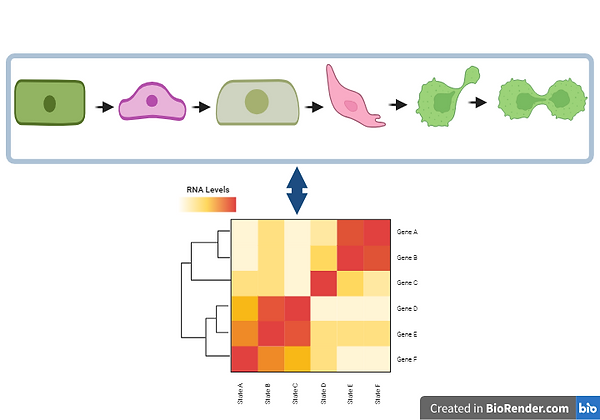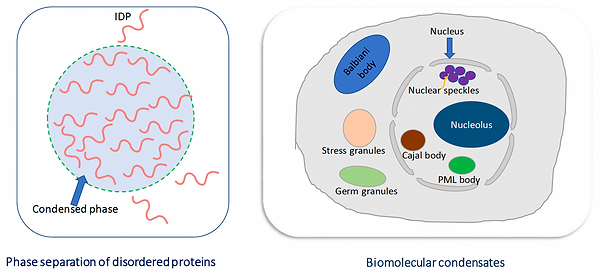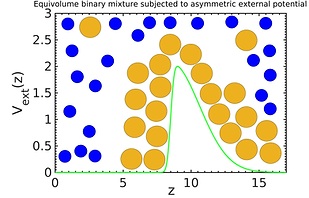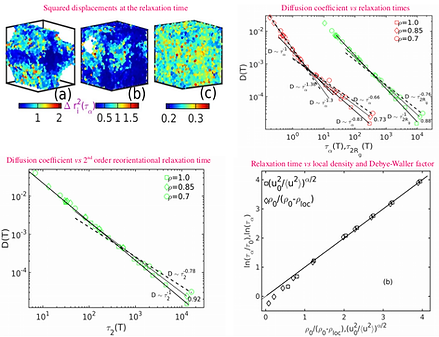Cell State Transitions

Morphodynamic State Changes
Variation in RNA Level of Genes
A "Cell State" can be associated with a variety of characteristics such as shape, size, morphology, the presence of specific RNA and/or protein molecules, and active or inactive promoter sites. Cells transition from one functional or phenotypic state to another during key biological processes such as embryonic development, tissue regeneration, and the adaptability of cancer cells. Decades ago, Waddington proposed that cells transition from one (metastable) state to another, akin to a marble rolling down a hill with many valleys. While Waddington's landscape provides a qualitative view of cell state transitions, understanding these transitions at the molecular level is crucial for advancing basic biological knowledge and developing targeted cancer therapies that effectively manage and potentially reverse undesirable cellular behaviors. Understanding how cells switch states in response to various signals and environmental conditions is pivotal to cellular resilience and plasticity. This knowledge is vital in cancer research, where malignant cells often hijack these transition pathways to promote growth and resist treatments. Gaining a deeper understanding of these processes offers the potential to develop more effective therapeutic strategies that can specifically target and disrupt pathological transitions, opening new avenues for treatment in oncology.
MCF10A, a non-tumorigenic cell line, could be a potential candidate to study cell state transitions under different ligand treatments. Comparing "control" versus "treatment" cellular behavior could be crucial in understanding these transitions. It is currently impossible to obtain all information characterizing a cell state using available technology; we cannot measure the state of all the molecules within a cell at once. However, the expression of "key" markers that potentially constitute a "functional cell state" can be measured using single-cell multi-omics technologies. Therefore, measuring a few cellular properties and developing a model to connect them is tempting. We characterize morphodynamic cell states and transitions between them by building the Markov State Model (MSM) from single-cell trajectories based on cellular features. Using linear algebra, we connect the morphodynamic cell states to RNA levels of genes, which are measured from the bulk RNA-seq experiments. We predicted RNA levels of each gene in morphodynamic cell states of the "test set" using machine learning, thus connecting cellular motion to molecules.
Publications from Zuckerman Lab in collaboration with Prof. Laura Heiser:
-
Jeremy Copperman, Sean M. Gross, Young Hwan Chang, Laura M. Heiser, and Daniel M. Zuckerman, Communications Biology (2023) 6:484.
-
J. Singh, J. Copperman, L. M. Heiser, D. M. Zuckerman, “Inferring single-cell dynamics of a molecular reporter from unlabeled live-cell light microscopy data analyzed with delay embedding”, bioRxiv: https://www.biorxiv.org/content/10.1101/2025.01.23.634593v1
-
Jeremy Copperman, Ian C. Mclean, Sean M. Gross, Jalim Singh, Young Hwan Chang, Daniel M. Zuckerman, and Laura M. Heiser, "Single-cell morphodynamical trajectories enable prediction of gene expression accompanying cell state change", bioRxiv: https://doi.org/10.1101/2024.01.18.576248
-
Oral & poster presentation in BPS 2024 on "A near-continuum model of morphodynamic single-cell states quantifying gene expression during epithelial-mesenchymal transitions"
Droplets within living cells
Membraneless organelles within cells are often termed cellular "condensates" or "droplets", e.g., stress granules, germ granules, nucleolus, nuclear speckles, etc., which form via a process known as liquid-liquid phase separation (LLPS), associated with weak multivalent interactions comprising proteins, RNAs, and DNA. These condensates form and dissolve within cytoplasm and nucleoplasm, dynamically, to perform various cellular functions, e.g., gene transcription, DNA replication and repair, protein synthesis, etc. Several diseases are believed to have originated due to irreversibility and misregulation of the droplets including cancer, Huntingtin disease, and amyotrophic lateral sclerosis; regulation of the droplets is performed by post-translation modifications, e.g., phosphorylation of protein residues, and RNA-mediated feedback control during gene transcription, etc. I am interested in the following questions:
Why are condensates necessary to perform several biological functions? What is the composition of proteins, RNAs, and DNA which gives rise to specific cellular functions? How do chemical reactions inside and outside the droplets affect their size, location, and growth? What is the role of chromatin in cellular condensates' formation, regulations, and diseases? The coarse-grained and all-atom MD simulations can be performed to unravel those questions.



Figure: (top-left) A schematic of a condensate consisting of intrinsically disordered proteins (IDPs) formed via the LLPS as well as many droplets within a cell. (top-right) A schematic of condensate formed in the proximity of the active site of chromatin. (bottom-left) The Flory exponent (FE) is plotted against the interaction energy between the amino acid residues of the C-terminal domain (CTD) of RNA polymerase II, exhibiting phase transition between dispersed (FE > 1/2) & condensed phases (FE < 1/3). This work is supported by the Robert Vacha group at Masaryk University, BRNO, Czech Republic.
Transport Across A Potential Barrier
In this work, we simulated a binary mixture of colloidal particles subjected to an asymmetric external potential along the Z-direction, published in J. Phys: Condens. Matter 33, 125101 (2021), arXiv link. This may be useful to understand transport across biological cell membranes.

A Coarse-grained Model of Quorum Sensing
We developed a model system for the dense active systems, where activity is introduced by the local density-dependent quorum sensing scheme (left-figure). By applying activity to the smaller particles of the binary colloidal mixture, the system shows phase separation of solid-like and liquid-like regions. We found that the stability in the solidlike phase is due to the least momentum transfer between active and passive particles in the phase separation regime. PRE 101, 022606 (2020) arXiv link


Violation of Stokes-Einstein & Stokes-Einstein-Debye relations in Supercooled Polymers
-
During my graduation, I have worked on the coarse-grained simulations of polymer melts (linear and branched) in the glassy state and analyze results using Statistical Mechanics. We have investigated violation of Stokes-Einstein and Stokes-Einstein-Debye relations in supercooled linear polymers, at the (dilute) gas and supercooled domains coexistence. Our results show that violation of these relations is due to a disparity in the motion of fast and slow particles (monomers). This could be relevant to the aggregation within cellular environments due to misregulation of droplets as described above. J. Phys.: Condens. Matter 33, 055401 (2021) arXiv link
-
We have coined a new relation between the structural relaxation time and local density (nearest neighbor peak of radial distribution function) in the supercooled linear polymer melt and Kob-Anderson binary mixture, which can be an alternative to the existing relation between the Debye-Waller factor and the relaxation time. AIP Conference Proceedings 2265, 030220 (2020); D. C. Thakur, Jalim Singh, Anna Varughese, Prasanth P. Jose, "Relation between local density and density relaxation near glass transition in a glass forming binary mixture", under review, arxiv Link .

